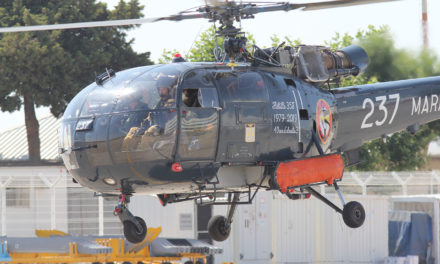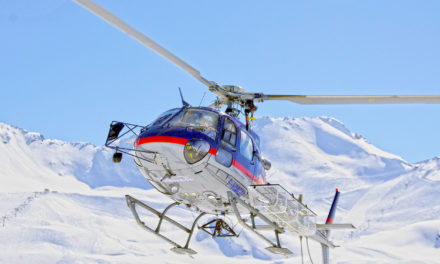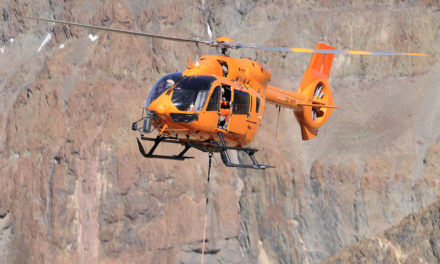Two years ago, Helicopter Industry interviewed Patrick Moulay, Executive Vice President of Commercial Sales and Marketing at Bell Helicopter, to gain a better understanding of the manufacturer’s strategy. In 2017, we took advantage of the Paris Air Show to meet with the executive once again, this time for a closer look at Bell’s position, news and plans for the future. Here’s the scoop.
How is Bell Helicopters doing on the market in 2017?
We have increased market shares, particularly thanks to orders for the Bell 505. This aircraft has had and will continue to have a significant impact on our market share in terms of volume. We had about 400 letters of intent to purchase for the 505, and about 80% of them have been confirmed. That figure goes beyond my expectations and confirms the success of this helicopter. Our current customers are sticking with us, showing real loyalty.
Overall, orders for the entire Bell range should increase by several points this year and next.
What kind of market potential does the Bell 505 have in Europe?
It has enormous potential. The first customers to express interest in the 505 were corporate customers, particularly Jet Ranger operators looking for a successor for that aircraft. Of course, many customers came our way because they wanted to acquire a turbine helicopter by a recognized brand, like Bell.
At the same time, we’ve also had interest from on-demand tourism flight operators. The first reason they were interested is the aircraft’s particularly low operating cost, which means they can increase their margins while flying the same number of passengers as they would on helicopters by competitor manufacturers positioned in a higher market segment.
The third very active market segment—in which I invest a lot of time—is the global military training market. I see it as a strategic, long-term market. We have a lot of orders in this segment. As for the air work market, we’ve started to see some interest, particularly in the crop dusting segment, which is of course a niche market. I’m also putting a lot into another segment: the semi-public surveillance and police market. It holds a lot of potential and demand for the Bell 505 should grow steadily in it over the next few years, as authorities replace their current fleets.
For now, our production chain is turning at full capacity for the next two years, and our number one goal is to deliver on time. As for moving into new markets, I think that will happen naturally.
Where do things stand between Bell and Airbus Helicopters following the injunction preventing Bell from using the sleigh-type landing gear on the 429 in France?
For my part, it’s ancient history. I did find it a shame, however, that our French customers were unable to take advantage of the 429 for several months, while the rest of the world had access to it. That said, I can guarantee you that the restriction had absolutely no impact on sales of the Bell 429 worldwide.
How many Bell 429s are currently in service?
We have delivered more than 300 of them. If you take a step back, you realize that this relatively young helicopter, launched just six years ago, is a great success when compared with the competition.
Are you thinking of building on that success with a new version of the Bell 429?
Our range is always evolving, either in terms of avionics suites or engine technology. As for the 429, we are not currently planning any major changes. That said, a few improvements should be announced soon.
Could you tell us where you are with the Bell 525?
Though we resumed flight testing in July, we have not forgotten that we are just coming out of a difficult period. No one in the helicopter industry makes it out of a crash like that emotionally unscathed.
The accident had a big impact on our teams. So, we’re just now making our way out of a difficult period. From a marketing and sales perspective, I’ve asked my teams to put things on pause for a while until the National Transportation Safety Board (NTSB) has issued a full report. After that we will begin pro-actively marketing the aircraft to our customers again. As for the program, we have continued to work on all non-flight components. We have taken advantage of the time on the ground to improve certain systems.
Do you have an idea of what caused the accident?
We know exactly what happened—down to the tiniest detail. That said, we cannot say any more at this time, since only the competent authorities may do so. They should be publishing their report in the very near future. However, I can already tell you that we have corrected the problem. What’s important to us is making sure this sort of situation never happens again, so we’ve obviously done what we needed to do to fix it. We can now enter a sales phase with our customers, and stay pragmatic in our approach. Despite this tragedy, we remain convinced that the 525 really fills a gap in the heavy helicopter segment.
Do you feel that the segment is no longer in crisis?
Everything is relative. There is no doubt the industry is facing hard times, Bell included. But there are two types of market in the oil & gas segment: the renewal market and the exploration and expansion market. I’m not going to lie: on the long-distance transportation market, everyone has cut their budget, and nothing I see tells me that we’re coming out of the tunnel any time soon. However, current operators need solutions. As a newcomer on this market segment, Bell Helicopter sees an opportunity to record new sales as operators update their fleets. Because even if they’re additional market shares, the contracts will be important for us.
There are a lot of helicopters out there (AH225, S-92, etc.) that need to be replaced. I think we can create value by offering customers the Relentless.
Don’t you think the super-medium segment will replace the heavy segment?
Yes, I do. I don’t think that the heavy market will ever reach its best figures again. If a mission can be done with a super-medium, there’s no point using an aircraft from a higher segment. Heavy helicopters will still be important for long distances and big payloads.
And that’s the niche Bell wants to get into. We think the 525’s economic model will allow operators to use it on both segments at once, thanks to low operating costs. Operators are trying to streamline their fleets, and I think the Bell 525 fits perfectly into the streamlining and optimizing mindset.
Do you have a potential rival for the H160 in the works?
It’s not about developing a competitor for the H160, but about deciding whether we need to replace the Bell 412. We are of course studying all our options, we are open to ideas.
What do you think of the Racer concept aircraft Airbus Helicopters launched at the Paris Air Show, particularly the emphasis on its speed capabilities?
I don’t have anything special to say about the Racer or its speed capabilities, which, need I remind you, are one of the 525’s main advantages.
We have tested the helicopter at over 200 knots (400 km/h) and it went well. It will probably be the fastest rotorcraft on the market, thanks in particular to its unique rotor design. During trials, our engineers recorded superior vibration control at 180 knots than what competitor aircraft provide at 130 knots. But the heart of our expertise is undoubtedly the tilt rotor, which plays a crucial role in our designs. We have learned a lot about it over the past 20 years with the V-22 Osprey. Tilt rotor technology has made Bell a unique manufacturer, and we believe in it, particularly with the V-280 Valor and the V-247.
Could you talk a little more about the V-280 program?
Given the scope of the contract, the V-280 is Bell’s priority. The FVL program includes the replacement of nearly 4,000 Blackhawks. It’s the second-biggest replacement program the U.S. Department of Defense has ever launched, just behind the one for the F-35.
The V-280 will be an incredible aircraft, and will undoubtedly change the size of the company. The prototype, which is currently undergoing ground tests, will begin flight testing this fall.
What does the FCX concept aircraft unveiled at Heli-Expo 2017 represent for Bell?
The FCX-001 is a signal to the market to start thinking about the future and what we’re working on from different perspectives, including design, avionics and hybrid engines. We want Bell to be seen as innovative.
This concept, which will never reach the market, also shows that, despite market difficulties, Bell is investing more than ever in innovation. Innovation is at the heart of the strategy developed by our CEO Mitch Snyder, who is able to look three decades ahead. So be ready for Bell Helicopter to bring new, innovative products to the market in the years to come.
The idea with a concept aircraft like the FCX-001 is also to attract new talent, a strategy learned from other big American technology companies like Apple, Tesla and Google. Helicopters are extraordinary, and we want them to continue to fascinate the public.
Could you tell us a little about your partnership with Uber?
Our strategic partnership with Uber is in line with our development strategy for our company and industry. Uber’s idea is to rethink urban transportation in the flying taxi segment. We want to be part of the revolution.
However, we have a marketing approach that differs from other manufacturers, because we want to analyze and understand what Bell Helicopter’s role will be in the segment. We know that the necessary legislation and technology will both take time. We will also need to stimulate the collective imagination and inspire confidence in the public to make them feel safe flying in an aircraft with no pilot. That will be a crucial step to making the concept viable.
By Frédéric Vergnères
©photo: Bell Helicopter Textron Inc
















